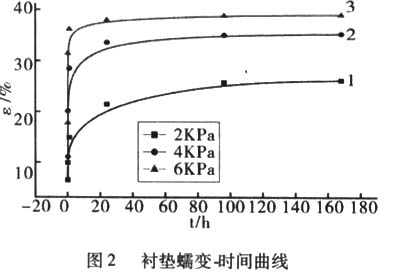2 Creep test
2.1 Test Principles and Methods "4"
Creep is a phenomenon that the deformation of the cushioning material increases with time under static external force. It is also caused by the plastic deformation of the material under external force. The test method is to apply a constant static stress to the buffer material over a period of time, and measure the thickness of the buffer material corresponding to the time, thereby obtaining the creep characteristics of the buffer material. The test was conducted in accordance with the "GB 14745 Creep Test Method for Packaging Buffers".
2.2 Test results
The creep performance of the liner was tested according to the method A. The liner density was 0.2 g·cm 3 , and the thickness was 45 mm. The test results are shown in Table 2. The liner creep-time curve is shown in FIG. 2 .


34, 67%, the maximum creep rate of the 3rd curve is 38.36%; as can be seen from Table 2, the residual stress after 24h unloading is 6.67%, 8.89%, 11.11%, respectively. As the static stress increases, it increases.
3 Conclusion
The expanded perlite liner and the EPE have the same static easing principle and are more suitable for buffer packaging of electronic products with relatively low product quality and product crispness, and still have good cushioning and recovery after multiple impacts. However, the density and application range of the expanded perlite cushioning liner are still somewhat different from those of the EPE and the EPS. In the future, further studies will be conducted on how to reduce the density of the cushion, increase the cushioning performance, and expand the application range.
(Wen/Cao Guorong, Xu Wencai, Yu Dongwei, Beijing Institute of Graphic Communication)
<Packaging Project>
Slimming Machine,Ems Sculpting Machine,Ems Sculpting
Xi'an Double H Health Technology Co., Ltd , https://www.xadoubleh.com